1
In the early 1820s settlement began on the shores of the Mississippi River at Apple Tree Falls where apple trees growing on the river banks had inspired the name. Soon after settlement began the area was renamed Teskeyville in honor of a family of settlers who arrived in 1823. In 1857 when the Post Office arrived, the village was renamed Appleton.The Teskey family came to Ramsay Township in 1823 as part of the Peter Robinson Settlers. This was a group of Irish emigrants who received support from the government to immigrate to Upper Canada. A similar group, the Lanark Society Settlers made up mostly of Scots, had arrived in 1820 and 1821. Both groups of settlers were mainly craftsmen hit hard by the depression following the Napoleonic War, many hand been looms men, cotton weavers and tradesmen.
2
Appleton, Ramsay Township, Lanark County1880
Appleton, Town of Mississippi Mills, Ontario, Canada
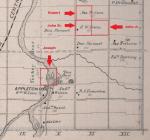 Credits:
Credits:McGill University, Rare Books Collection
3
John Teskey Sr. (age 44) and his wife, Ann Vail, came from Rathkeale in Limerick Ireland to Ramsay Township in 1823 with eight of their children. John Teskey Sr. received the West half of Lot 7 Concession 11 while his son, John Jr. (age 20), received the adjoining East half of Lot 7 Concession 11. The other two adult sons, Joseph (age 24),) and Robert (age 22) received the West half of Lot 4 Concession 10 and the West half of Lot 8 Concession 11, respectively.It was the West half of Lot 4 Concession 10 owned by Joseph Teskey that became home to the Mills of Appleton. Joseph's lot was split down the centre by the Mississippi River at a natural set of falls. The two brothers Joseph and Robert capitalized on this natural gift and harnessed the water power by building two mills: a sawmill and a gristmill.
4
Mississippi River, Appleton, photo by Malak Karsh1945-1946
Appleton, Town of Mississippi Mills, Ontario, Canada
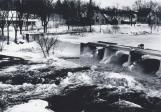 Credits:
Credits:North Lanark Regional Museum (2012.79.12.26)
Photographer: Malak Karsh
Donated by Eleanor Wright & Irene Dunn Thompson
5
Beside the Appleton Hydro Plant on the Mississippi River13 November 2012
Appleton, Town of Mississippi Mills, Ontario, Canada
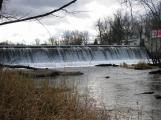 Credits:
Credits:North Lanark Regional Museum (2012.91.82)
Photographer: Sarah Bennett
6
Having emigrated from Limerick, Ireland, Joseph and Robert Teskey most likely had experience working in mills. They were extremely fortunate that their land grant provided access to the natural falls on the Mississippi River, the perfect place to build a mill. On the West side of the river Robert Teskey built a sawmill while on the East side of the river Joseph Teskey built gristmill.7
Sawmill and Grist Mill at Appleton1880
Appleton, Town of Mississippi Mills, Ontario, Canada
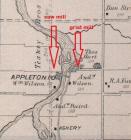 Credits:
Credits:McGill University, Rare Books Collection
8
The sawmill was an important industry for the growth of Appleton. The mill provided jobs for men in the community and provided lumber for the construction of homes and barns in the area. In the earliest years, the mill would have been supplied by local lumber as residents cleared their new homesteads and the surrounding bush. Eventually lumber from greater distances would have been used.Logging typically took place during the winter months when the large logs could be transported by horse and sleigh over the snow. The logs would be brought to the nearest river where they would begin their journey in the spring. The spring thaw opened the rivers and allowed the men to float the logs from the forest to the mills. Using chains the logs were floated in large "booms" to the appropriate mill.
9
Log Booms at Burnstown on the Madawaska River1820-1920
Madawaska River, Burnstown, McNab Township, Renfrew County, Ontario
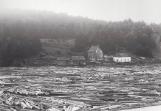 Credits:
Credits:North Lanark Regional Museum (2012.36.8.17)
10
Log Booms at Burnstown on the Madawaska River1820-1920
Madawaska River, Burnstown, McNab Township, Renfrew County, Ontario
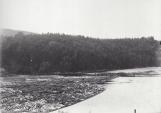 Credits:
Credits:North Lanark Regional Museum (2012.36.8.18)
11
Log boom on Mississippi River, 19021902
Mississippi River, Lanark County, Ontario, Canada
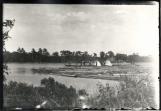 Credits:
Credits:Carleton Place and Beckwith Heritage Museum (2005.14.18)
12
In order to get a supply of logs for the mill Robert Teskey purchased standing timber and hired loggers to cut it and bring it down the Mississippi River. From forest to mill, the logs might travel hundreds of kilometres.Lumbermen spent the winters in logging camps cutting logs and bringing them by horse drawn sleigh to the river. When the ice finally broke in the spring, the men started driving the logs down the river to the mill. The men had to be careful that the logs didn't jam. This was a very dangerous task and in the early years the men used long wooden poles to prod the logs as they floated down the river. In the late 19th century peaveys were introduced as a safer and more efficient tool for rolling logs. Peaveys are a tool with a long wooden pole with an iron hook at the end designed to roll or steady logs.
One of the major lumber companies in Lanark County was the Gillies Brothers Ltd. They may have supplied some of the logs sawed in Appleton.
13
Gillies Lumbering, Some Ramsay Township Men in the GangLate 1800s Early 1900s
Lanark County, Ontario, Canada
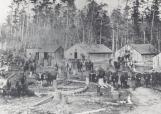 Credits:
Credits:North Lanark Regional Museum (2013.9.19)
Donated by Jim Lowry
14
Gillies Lumbering, Unloading Logs into the WaterLate 1800s Early 1900s
Lanark County, Ontario, Canada
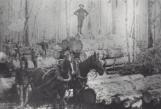 Credits:
Credits:North Lanark Regional Museum (2013.9.20)
Donated by Jim Lowry